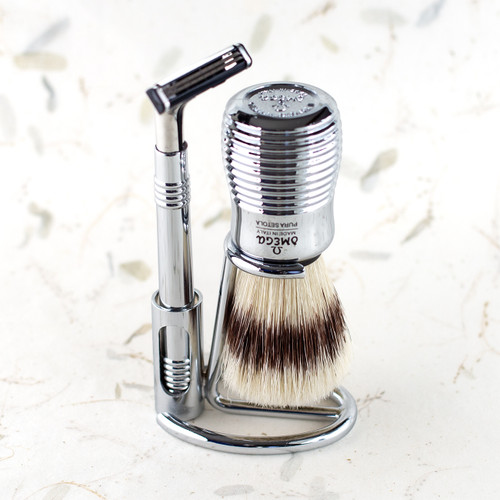Description
Three-fork brush and/or razor component to make your own DIY shaving brush and razor stand. Comes in option of nickel or gold plated. Great for woodturners and metalsmiths who want to make a custom mulit-brush/razor holder.
- SPECS:
- Forks:
- Large brush fork inside opening: 31mm
Normal brush inside opening: 25mm
Razor inside opening: 12mm
Fork wire: 3mm round - Center ring:
Round center part, outside diameter (top): 14mm
Round center part, indented flange diameter (bottom): 11mm
Round center part, inside hole diameter: 6mm
Round center part, depth including flange: 5mm
Conversions:
31mm = 1.22047"
25mm = 0.984252"
12mm = 0.472441"
14mm = 0.551181"
11mm = 0.433071"
6mm = 0.23622"
5mm = 0.19685"
FYI: The razor fork can be slippery for holding certain razors. Therefore, an anti-slip coating on the fork, or inside of the fork, can solve this problem. Em uses a thin layer of E6000 or other metal anti-slip mediums on the inside of the fork and lets it cure. There are mediums on the market that can be experimented with. A razor with a bulbous section larger than the fork opening at the top of a razor handle will help when no anti-slip agent is used. In addition, typically this is not a concern with double edge razors since they generally rest on top of the fork.
Creatives: You can sever the fork/s at the area where it meets the center component and use individually. Would need to think outside of the box about how to affix it to a post or backing material, for example wood. Spec: 19mm (0.748031) between the back of the fork and the round center component - which leaves enough clearance for hanging most normal size brushes or razors if the fork arm is inserted into a backing about 6 +/-mm. You do this at your own risk as there is no refund or exchanges.
~ Please note: Measurements are approximate and each person should perform their own measurements before starting any project. Various monitors can show colors or shades that my vary slightly from what is pictured for actual product.














